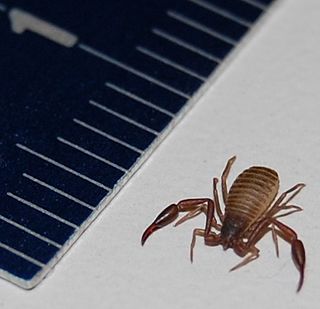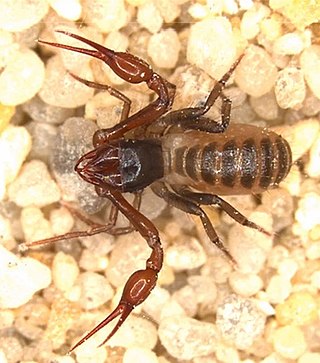
Chernetidae is a family of pseudoscorpions, first described by Anton Menge in 1855.
Atemnidae is a family of pseudoscorpions, first described by Kyukichi Kishida in 1929.
Synsphyronus is a genus of pseudoscorpions in the Garypidae family. It was described in 1930 by American arachnologist Joseph Conrad Chamberlin. Its distribution is mainly in Australia, but also extends to New Zealand and New Caledonia.

Garypus is a genus of pseudoscorpions in the family Garypidae. It was described by German arachnologist Ludwig Carl Christian Koch in 1873. The species are found mainly in tropical and subtropical areas, where they occupy supralittoral and littoral zones in seashore habitats.

Cheliferidae is a family of pseudoscorpions in the order Pseudoscorpiones, first described by Antoine Risso in 1827.
Hesperochernes is a genus of pseudoscorpions in the family of Chernetidae.

Withiidae is a family of pseudoscorpions, first described by Joseph Conrad Chamberlin in 1931.
Austrochthonius is a genus of pseudoscorpions in the family Chthoniidae. It was described in 1929 by American arachnologist Joseph Conrad Chamberlin.
Lagynochthonius is a genus of pseudoscorpions in the family Chthoniidae. It was described in 1951 by Austrian arachnologist Max Beier.

Tyrannochthonius is a genus of pseudoscorpions in the family Chthoniidae. It was described in 1929 by American arachnologist Joseph Conrad Chamberlin.

Pseudotyrannochthonius is a genus of pseudoscorpions in the family Pseudotyrannochthoniidae. It was described in 1930 by Austrian arachnologist Max Beier.
Ideoblothrus is a genus of pseudoscorpions in the Syarinidae family. It was described in 1892 by Italian naturalist Luigi Balzan as a subgenus of Ideobisium.

Dactylochelifer is a genus of pseudoscorpions in the family Cheliferidae, first described by Max Beier in 1932.
Americhernes is a genus of pseudoscorpions in the Chernetidae family. It was described in 1976 by American arachnologist William Muchmore.
Americhernes muchmorei is a species of pseudoscorpion in the Chernetidae family. It is endemic to Australia. It was described in 1990 by Australian arachnologist Mark Harvey. The specific epithet muchmorei honours American arachnologist William Muchmore (1920–2017) who described the genus Americhernes.
Americhernes neboissi is a species of pseudoscorpion in the Chernetidae family. It is endemic to Australia. It was described in 1990 by Australian arachnologist Mark Harvey. The specific epithet neboissi honours Latvian-Australian entomologist Arturs Neboiss (1924–2010) who collected the holotype.
Cordylochernes dingo is a species of pseudoscorpion in the Chernetidae family. It is endemic to Australia. It was described in 1990 by Australian arachnologist Mark Harvey. The specific epithet dingo refers to the type locality.
Megachernes is a genus of pseudoscorpions in the Chernetidae family. It was described in 1932 by Austrian arachnologist Max Beier.

Withius is a genus of pseudoscorpions in the Withiidae family. It was described in 1911 by English zoologist Harry Wallis Kew. The generic name Withius honours Danish arachnologist Carl Johannes With (1877–1923).
Pseudochiridium is a genus of pseudoscorpions in the Pseudochiridiidae family. It was described in 1906 by Danish arachnologist Carl Johannes With.






